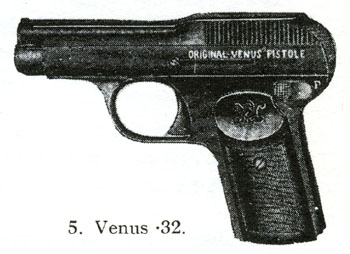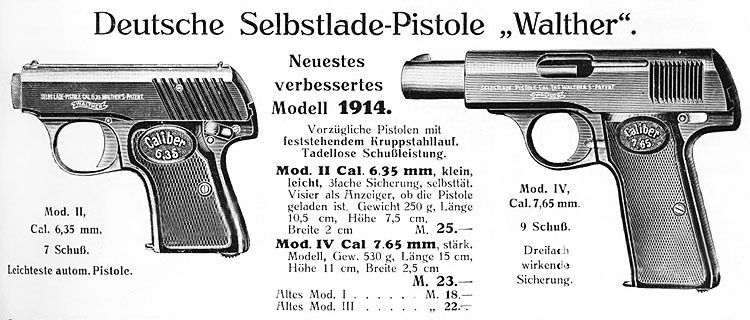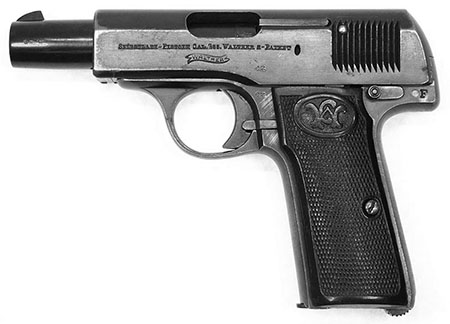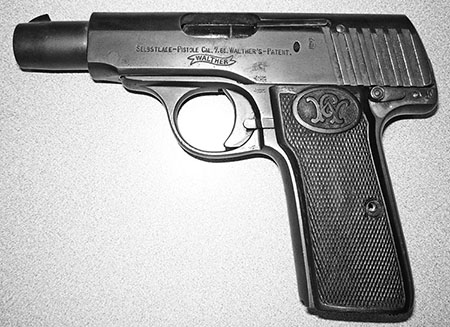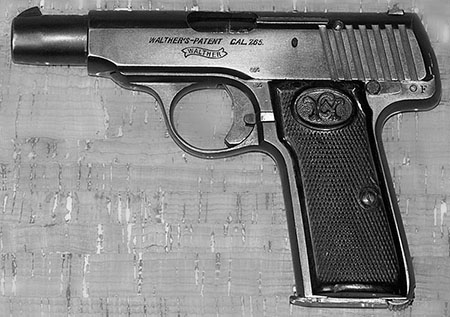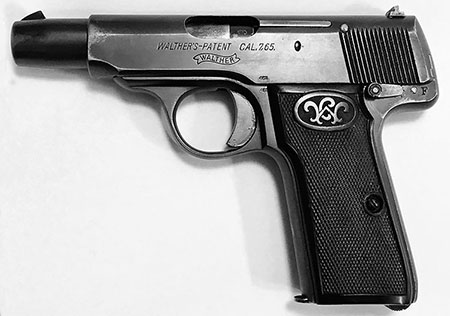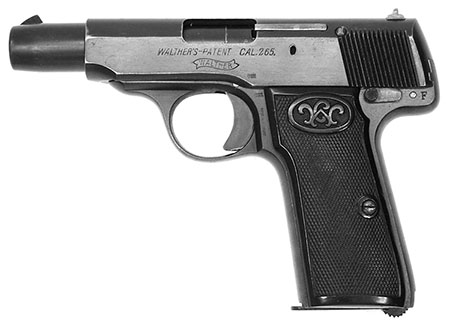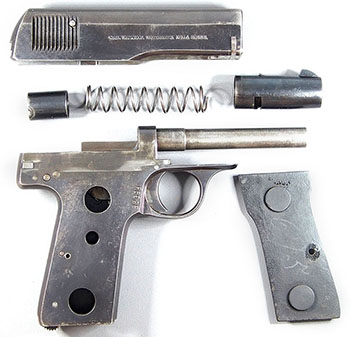|
The Walther Model 4
by Ed Buffaloe
The Walther Company was founded in 1886 by Carl Walther in the town of Zella St. Blasii, Thuringia, a traditional metalworking and weapon-making area in Central Germany. The town was renamed Zella-Mehlis
after 1919. The Walther Company manufactured rifles and shotguns that were hand fitted, and quickly gained a reputation for superior quality that has remained associated with the Walther name to this day.
Three of Carl’s five sons, Fritz, Georg, and Hans Erich, took over the family business after the death of their father in 1915.
By 1908, Carl and his son Fritz had produced prototypes of both a .32 and a .25 caliber pistol. According to some sources, the .32 was designated the Venus-Pistole and had its recoil spring mounted over the barrel, like the 1900 Browning. The .32 Venus-Pistole was never manufactured but
an image of it was published in H. B. Pollard’s book Automatic Pistols in 1921.
The Walther Company began manufacturing its first .25 caliber pistol in 1910 or possibly 1911, later christened the Model 1. The Model 1 was slightly smaller and lighter than the 1906 FN Browning,
but was similar in design, with the recoil spring beneath the barrel and a spring-loaded striker, but with a fixed barrel, the extractor on top of the gun, and the slide cut away in front to reveal the
barrel. Beautifully made and with excellent fitment, the Walther was an instant success, with sales of just over 30,000 by 1915.
The Model 1 was followed by the Model 3 and Model 2, which were simplified in design, used a
hammer instead of a striker, and had the recoil spring around the barrel. According to Dieter Marschall, both the Model 2 and the Models 3 and 4 appeared in 1913. I suspect he is correct in
light of the fact that we see Model 3 pistols with barrels identical to those on the Model 4. James Rankin suggests much earlier dates for all these pistols, as does Manfred Kersten, but the early
dates do not seem credible in light of the fact that the first patent was not granted until 1913, and even the earliest Model 2 and 3 pistols we have documented are marked “Walther’s Patent”. The earliest advertisement I have located for the Model 4 is dated 1914 and refers to both guns as the Model 1914. According to Gene Gangarosa, Walther received an order from the Prussian
government in May of 1915, eight or nine months after the beginning of World War I, for 250,000 Model 4’s.
The design of the Model 4 is based on a patent that was filed on 22 October 1911, German patent 256606; however, this patent was not granted until 17 February 1913. This patent covers only the
method of assembly and disassembly using a bushing at the front of the slide which is secured by bayonette lugs, which are specifically mentioned in the patent. My personal belief is that the
design of the Walther Model 3, which lacks the bayonette lugs and upon which the early Model 4 is based, is an earlier form of the design shown in the patent.
The Model 4 is a relatively simple handgun of an unlocked breech “blowback” design, with a fixed barrel, an external extractor, and a concealed hammer. Its most unusual feature is that (like
its predecessor the Model 3) its ejection port and extractor are on the left. The barrel acts as a guide for the concentric recoil spring, which is held in place by a bushing attached to the front of
the slide and by a sleeve at the rear which also serves to cover the spring. When the slide moves rearward, it forces the trigger bar down, disconnecting it from the sear. The safety is a rotating
thumb lever that positively locks the cocked hammer. The manual safety thumb grip area has two circular grooves or is checkered on some later models. There is a screw on the backstrap of the
grip that regulates the tension of the flat hammer spring. The gun is slim and elegant, well-balanced, fits the hand very nicely, and points instinctively. It is also reasonably accurate.
In the approximately 16 years of its manufacture, there were four types of the Model 4. I have loosely defined a type as a gun which exhibits distinct external differences other than slide
inscriptions. The dates and serial numbers given below are approximate and subject to revision, pending further information.
Type 1 (Commercial production.)
- Sometimes referred to as the transitional model, or Model 3/4, because it retains the release for the front recoil spring bushing at right front of slide, similar to the Model 3.
- Approximate serial number range: 29,000 - 34,940*
- Left side of slide marked:
- in serif capitals on two lines: “SELBSTLADE-PISTOLE CAL. 7,65. WALTHER’S-PATENT / MADE IN GERMANY” with no banner.
- in serif capitals “SELBSTLADE-PISTOLE CAL. 7,65. WALTHER’S-PATENT” with no banner.
- in serif capitals “SELBSTLADE-PISTOLE CAL. 7,65. WALTHER’S-PATENT” on one line above the Walther banner.
- The right side of the slide:
- in all capital serif characters “MADE IN GERMANY”.
- On interim pistols the right side of the slide was blank.
- Later pistols had, in mixed capitals, “CARL WALTHER WAFFENFABRIK ZELLA ST.BLASII” on one line.
- Top of slide is rounded and lower front edge of slide is squared off.
- 12 triangular cut vertical slide serrations.
- The last Type 1 pistols produced (approximately serial numbers 33900-34940) have 7 square-cut slide serrations slanted toward the front, like the Type 2, but retain the release lever for
the front recoil spring bushing at the right front of the slide.
- Safety lever has two circular grooves.
- Partially exposed trigger-bar on left side of receiver.
- No rear sight, but had a groove along the top of the slide.
- Triangular or ramped front sight.
- Rust blue finish.
- Oval ejection port.
Early Type 2 (Late commercial and early wartime production.)
- Approximate serial number range: 35,000 - 60,000*
- The release lever for the front bushing is omitted. The new front bushing is mounted bayonette-style.
- Lower front edge of slide rounded/scalloped.
- Left side of slide marked:
- in serife capitals “SELBSTLADE-PISTOLE CAL. 7,65. WALTHER’S-PATENT” on one line above the Walther banner,
- or later in sans-serif capitals “SELBSTLADE-PISTOLE CAL. 7,65. WALTHER’S-PATENT”.
- Right side of slide marked:
- in mixed capitals “CARL WALTHER WAFFENFABRIK ZELLA ST.BLASII” on one line,
- or in mixed-case sans-serife letters, “Carl Walther. WAFFENFABRIK Zella St.Blasii.”
- 7 angled square-cut slide serrations.
- Safety lever has circular grooves.
- Partially exposed trigger-bar on left side of receiver.
- Slide is about ¼-inch longer than First Variant. Top of slide still rounded.
- No rear sight, but has groove along the top of slide.
- Front sight is triangular.
- Oval ejection port.
- At around serial number 50,000 we begin to see imperial stamps on the left side of the slide.
Late Type 2 (Wartime and post-war production,1916?-1919?)
- Approximate serial number range: 60,014 - 225,056* There is often no clear distinction
between early and late Type 2 pistols but, in general, the later guns are characterized by greater heterogeneity.
- Somewhere in the vicinity of serial number 60,000 we begin to see safety levers with checkering as well as with grooves.
- Licensed production by other companies begins soon after serial number 60,000 and such guns are marked to indicate the maker (see below). Right side of slide is blank on licensed guns not made by Walther.
- Early guns made by Meffert and other licensees may have hemispherical front sights.
- Left side of slide marked:
- in sans-serif capitals “SELBSTLADE-PISTOLE CAL. 7,65. WALTHER’S-PATENT”.
- in italic sans-serif capitals “WALTHER’S-PATENT CAL. 7,65”on one line above the Walther banner.
- Right side of slide marked:
- “Carl Walther. WAFFENFABRIK Zella St.Blasii.”
- in or around April 1919, at approximately serial number 215810, (in sans-serif capitals) “WAFFENFABRIK WALTHER ZELLA-MEHLIS I”
- or “CARL WALTHER WAFFENFABRIK WALTHER ZELLA-MEHLIS I”
- or in italic sans-serif capitals “WAFFENFABRIK WALTHER ZELLA-MELLIS” .
- Early guns have no rear sight but gradually we begin to see guns with a drift-adjustable rear sight. These later guns often have a less-rounded slide profile.
- Oval ejection port.
|
Licensed Production of the Walther Model 4
During World War I Walther was unable to produce enough pistols on their own so they licensed Immanuel Meffert of Suhl, a well known manufacturer of hunting and sporting
guns with which Walther had a longstanding relationship, to make the Model 4 between December 1915 and March 1917. Meffert was also unable to produce enough pistols and so
sub-contracted with a number of other firms. Guns made under license by firms other than Walther are usually marked on the left or right side trigger guard bow. Many of these
guns have the serial number stamped on the left side of the slide. Some of Meffert’s pistols are stamped on the left side of the slide “Imman. Meffert,
Suhl”. Known markings are as follows:
Anchor - Heinrich Krieghoff, Suhl
AS - August Schuler, Suhl
F - Christoph Funk, Suhl
F.W.K. - F. W. Kessler, Suhl
G - H.M. Gering, Heidersbach
GM
- Gebruder Merkel, Suhl (intertwined GM in a shield)
GR - Gebruder Rempt, Suhl
IM - Immanuel Meffert, Suhl
M - Mercedes Bureaumaschinen, Mehlis (M in an
oval)
S&H - Schmidt & Haberman
|
|
|
Type 3 (Post-war production, 1922?-1924?)
- Approximate serial number range: 225,972? - 250,000?*
- Left side of slide marked:
- (in capitals) “WALTHER’S-PATENT CAL. 7,65” on one line above the Walther banner.
- Some may be marked only “PATENT CAL.7,65”.
- Late guns are marked (in lower case italics) “Walther’s Patent Cal. 7,65” on one line above
the Walther banner.
- Right side of slide marked:
- (in capitals) “WAFFENFABRIK WALTHER ZELLA- MEHLIS” on one line.
- Late guns marked (in lower case italic) “Waffenfabrik Walther Zella-Mehlis (Thür.)” on one line.
- 16 fine triangular-cut slide serrations angled forward.
- Early safety levers have circular grooves, but most later guns checkered safeties.
- Internal trigger bar.
- Drift adjustable raised rear sight in a dovetail mount.
- Oval ejection port.
Type 4 (Limited production, 1924?-1929.)
- Approximate serial number range: 250,000? - 266,000 and 480,000 to
500,000.*
- Same as Type 3, except with a more rectangular ejection port. Some might consider the Type 4 to be simply a variant of the Type 3.
- Checkered safety lever.
Disassembly
-
Remove the magazine.
- Draw the slide back to make sure the chamber is empty and to cock the hammer.
- Press in on the barrel bushing, turn it counterclockwise (as you face the front of the gun), and draw it carefully off the end of the barrel under pressure from the recoil spring.
(For Type 1, with a hand on the front of the gun to catch the barrel bushing, press down on the latch on the right front side of the slide.)
- Remove the recoil spring and sleeve by twisting them off the barrel.
- Pull the slide all the way to the rear, lifting the front of the slide slightly to get it all the way back, then lift the rear of the slide up and
off the rails and pull the slide forward and off the barrel.
Do not pull the trigger with the gun disassembled, as it could damage the lockwork. If the grips are removed from the early models with the external trigger bar, the trigger bar may fall out.
Reassembly is the reverse of disassembly. There is a little trick to getting the slide back on the
receiver, but it is best learned by experience. With the slide pulled all the way to the rear, press down on the rear of the slide and push toward the front.
Considering its age, the Walther Model 4 generally holds up very well. J.B. Wood reports that sometimes the hammer spring tension screw on the backstrap will come loose, causing misfires
due to light primer strikes. This is easily remedied by tightening the screw. I had the front sight on mine fly off the gun during firing. I bought a bar magnet with a long handle at Home Depot and
recovered the sight—it had landed in the dirt behind me.
* I would appreciate hearing from owners of Model 4 pistols. Send me photographs and/or descriptions of your guns along with
serial number information. I will try to make the information given here more accurate. edbuffaloe@unblinkingeye.com
|
|
1910 Browning
|
Walther Model 4
|
|
Cartridge
|
7.65mm / .32 ACP
|
7.65mm / .32 ACP
|
|
Magazine Capacity
|
7 rounds
|
8 rounds
|
|
Overall Length
|
6 inches / 153mm
|
5.94 inches / 151mm
|
|
Overall Height
|
3.91 inches / 99.4mm
|
4.05 inches / 102.9mm
|
|
Grip Depth at Base
|
1.67 inches / 42.4mm
|
1.62 inches / 41.2mm
|
|
Barrel Length
|
3.44 inches / 87.5mm
|
3.46 inches / 88mm
|
|
Slide Width
|
.8 inches / 20.3mm
|
.8 inches / 20.5mm
|
|
Weight Empty
|
19.6 ounces / 554.8g
|
18.42 ounces / 521.2g
|
|
Dating the Early Walther Pistols, Models 1-7
|
|
|
References
- Adamek, Robert J. Pistols of World War I, Pentagon Publishing, Pittsburg: 2001.
- Hogg, Ian V. German Handguns, Greenhill, London: 2001.
- Gangarosa, Gene Jr. The Walther Handgun Story, Stoeger Publishing, Wayne, NJ: 1999.
- Kersten, Manfred. Walther: A German Legend, Safari Press, Long Beach, CA: 2001.
- Marschall, Dieter H. Walther Pistols, Models 1 to PPX, Mott Lake Publishing: 2016.
- Pollard, Hugh B. C. Automatic Pistols. 1921. Reprinted by WE, Greenwich, Connecticut.
- Rankin, James L. Walther Volume III: 1908-1980, Self-published: 1981.
- Smith, W.H.B. Walther Pistols, Stackpole, Harrisburg, Pennsylvania: 1946.
- Still, Jan C. Central Powers Pistols, Still’s Books, Douglas, Alaska: 2007.
- Wood, J. B.Troubleshooting Your Handgun, Follett, Chicago: 1978.
|
|
|


